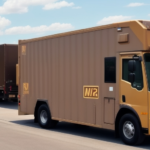How to Request an Express Early UPS Shipping Charge Correction
Organizations that frequently ship packages via UPS may occasionally face inaccurate charges. Oversights in package weight and dimensions, incorrect service type selection, and unapproved accessorial fees can all result in increased shipping costs. To get back on track and ensure accurate future charges, UPS offers its Shipping Charge Correction process. This guide provides an overview of the process, helps you identify common inaccuracies in shipping charges, and offers a step-by-step guide to request an express early UPS shipping charge correction.
Overview of the UPS Shipping Charge Correction Process
Understanding the UPS Shipping Charge Correction process is crucial for managing your shipping expenses effectively. This procedure allows you to request adjustments to previously charged shipment fees based on the following issues:
- Invoicing issues
- Incorrect shipment dimensions or weight
- Incorrect tariff or service options
- Additional surcharges or fees applied without consent
- Service failure claims
This process applies to UPS ground, express, and international shipments.
When submitting a request for a shipping charge correction, it's essential to provide all necessary documentation to support your claim. This may include invoices, receipts, and shipment details such as weight and dimensions. Incomplete documentation can lead to delays or denial of your request.
Additionally, the UPS Shipping Charge Correction process has strict time limits. Requests must be submitted within 15 days of the invoice date for domestic shipments and 30 days for international shipments. Requests submitted after these periods may not be eligible for correction.
Understanding the Different Types of UPS Shipping Charges
Before initiating a shipping charge correction, it's essential to understand the various UPS shipping charges. UPS defines inaccuracies for all its shipping services. Some common charges and fees include:
- Additional handling fees
- Fuel surcharges
- Oversize fees
- Residential delivery fees
- Declared value charges
These charges can vary depending on the shipping service and destination. For instance, international shipments may incur additional customs fees and taxes. Some items may also be restricted or prohibited from shipping, leading to extra fees or shipment cancellations. It's recommended to review the UPS website or consult with a UPS representative to fully understand the shipping charges and fees associated with your specific shipment.
According to a 2023 UPS report, accurate shipment details can reduce charge corrections by up to 20%, highlighting the importance of precise shipping information.
How to Identify Inaccurate UPS Shipping Charges
Identifying inaccurate UPS shipping charges requires careful examination of your shipment details and invoices. Here are some common errors to watch for:
- Surcharges for services not used
- Incorrect package dimensions or weight
- Incorrect tariff classifications
- Incorrect residential delivery designation
One effective method is to compare your invoices with the rates listed on the UPS website. Discrepancies can help spot billing errors and ensure accurate charges. Additionally, tracking any refunds or credits you may be entitled to is beneficial, as UPS offers guarantees and service refunds for late or incorrect deliveries.
For a more thorough analysis, consider using a third-party auditing service. These services provide comprehensive analysis of your shipping data and invoices, potentially recovering significant amounts of money. Ensure you choose a reputable and experienced auditing company for reliable results.
Tips for Calculating Accurate UPS Shipping Costs
To prevent the need for future shipping charge corrections, accurately calculate your shipping costs during the initial shipping process. Consider the following tips:
- Accurate Measurements: Measure your packages precisely and weigh them. Small differences can lead to significantly higher shipping costs.
- Service Level Selection: Choose the appropriate service level that matches your delivery requirements. Selecting an expedited service for a standard delivery can inflate costs.
- Double-Check Labels: Ensure shipping labels match the package contents to avoid errors.
- Avoid Unnecessary Options: Eliminate any unnecessary shipping options or add-ons, such as signature confirmation, if they don’t serve your specific needs.
The destination of your package also impacts shipping costs. For example, shipping to a residential address may incur higher costs than to a commercial address due to additional handling and delivery services. Accurately identifying the destination ensures you choose the appropriate service level and avoid unexpected charges.
Step-by-Step Guide: Requesting a UPS Shipping Charge Correction
When you've identified an error in your shipping charges that requires correction, follow these steps:
- Log in to your UPS account and navigate to 'Billing and Payment Centers'.
- Select 'Submit a Claim'.
- Complete the form, including all shipment details such as the original tracking number, package weight and dimensions, and the service type used.
- Receive confirmation of your claim submission from UPS.
- Within a few days, UPS will audit your invoices and send a report indicating any credits due.
For express early corrections, UPS provides a phone number for urgent correction requests. Ensure you adhere to the time limits: claims must be submitted within 15 days of the invoice date for ground shipments and within 7 days for air shipments. Late submissions may not be eligible for correction.
Common Reasons for Incorrect UPS Shipping Charges and How to Avoid Them
Several factors can lead to incorrect UPS shipping charges:
- Failure to specify the type of delivery service
- Inaccurate package size and weight measurements
- Unnecessary additional charges
- Incorrect carrier and transportation mode selection
- Incorrect labeling and package details
To avoid these issues, ensure all shipment details are accurate and double-check your invoices for any unnecessary charges. Proper packaging is also crucial; incorrect packaging can lead to damage during transit, resulting in additional charges or shipment returns. Use appropriate packaging materials and follow UPS guidelines for packaging and labeling.
Consider the shipment destination when selecting the carrier and transportation mode. Different carriers may offer better rates or faster delivery times for specific regions or countries. Also, ensure compliance with any customs or import/export regulations and include all necessary documentation.
How to Expedite Your UPS Shipping Charge Correction Request
If you need a prompt shipment correction, consider the following steps to expedite the process:
- Contact UPS Directly: Call UPS and provide all necessary shipment information.
- Include Relevant Documents: Submit all pertinent details and documentation in your initial claim submission through the UPS portal.
- Follow Up: Regularly check in with UPS on the status of your correction request, as they may require additional information.
UPS may offer refunds or credits depending on the circumstances. If you believe you’re entitled to a refund or credit, inform the UPS representative during your request. Additionally, consider enrolling in the UPS My Choice program, which offers additional benefits and tools for managing your shipments efficiently.
What to Do if Your UPS Shipping Charge Correction Request is Denied
If UPS denies your shipment correction request, consider the following actions:
- Review Your Submission: Ensure all necessary shipment details were included in your correction request.
- Contact Customer Service: If you believe the denial was incorrect, reach out to UPS customer service for a reassessment.
- Use Third-Party Services: Consider working with a third-party shipping solution service to improve accuracy and eliminate errors in your shipping invoices.
UPS may deny a correction request if it’s submitted after the allowed time frame. To prevent this, submit your request as soon as possible after the shipment is processed. If you frequently encounter issues with UPS shipping charges, explore alternative shipping options or negotiate rates directly with UPS.
Best Practices for Managing Your UPS Shipping Costs
To effectively manage and reduce your shipping costs in the long term, implement the following best practices:
- Invest in Shipping Software: Utilize software that automatically calculates accurate shipment costs based on weight, dimensions, and service type.
- High-Volume Discounts: Take advantage of high-volume shipping discounts that carriers offer to regular shippers.
- Consistent Tracking: Track shipment details consistently to identify patterns and errors in the shipping process.
- Outsource Shipping Needs: Consider outsourcing to a third-party logistics company, which can help negotiate better rates or offer savings through bulk shipments and optimized route planning.
Optimizing your packaging is another crucial aspect. Using the right size and type of packaging can help you avoid dimensional weight charges, significantly reducing shipping costs. Additionally, using eco-friendly packaging materials can save money while also minimizing environmental impact.
Stay updated on carrier rate changes and adjust your shipping strategy accordingly. For example, if a carrier increases rates for a particular service, consider switching to an alternative service or carrier to maintain cost efficiency. Regularly reviewing and adjusting your shipping strategy helps you stay ahead of cost increases and save money in the long run.
Benefits of Regularly Reviewing and Correcting Your UPS Shipping Charges
Regularly reviewing and correcting UPS shipping charges offers multiple benefits:
- Cost Reduction: Identify and eliminate overcharges to reduce overall shipping expenses.
- Accurate Records: Maintain precise shipping records for better financial management.
- Improved Efficiency: Streamline the shipping process by correcting inaccuracies promptly.
- Enhanced Customer Satisfaction: Provide reliable shipping services by ensuring accurate and timely deliveries.
- Increased Profits: Reduce unnecessary costs to improve your bottom line.
By proactively managing shipping charges, you enhance operational efficiency and provide better service to your customers, ultimately contributing to your business's success.
Alternatives to Using UPS for Your Shipping Needs
While UPS is a popular and reliable shipping solution, several other options are available that may offer competitive rates and discounts suitable for your business:
- FedEx: Known for its reliable international shipping and extensive tracking capabilities.
- DHL: Offers comprehensive global shipping solutions, particularly strong in Europe and Asia.
- USPS Priority Mail: Provides cost-effective shipping options, especially for small packages within the United States.
- Regional Courier or Logistics Services: Local carriers can offer faster delivery times and competitive rates for specific regions.
Reviewing all available shipping options ensures you’re getting the best possible deal tailored to your business's specific needs. Consider factors such as delivery speed, cost, reliability, and customer service when choosing a shipping provider.
Additional Resources
For more information on UPS Shipping Charge Corrections and to stay updated with the latest policies, visit the UPS Charge Correction Help Center.
Stay informed by consulting industry reports and authoritative sources to optimize your shipping strategy effectively.






















